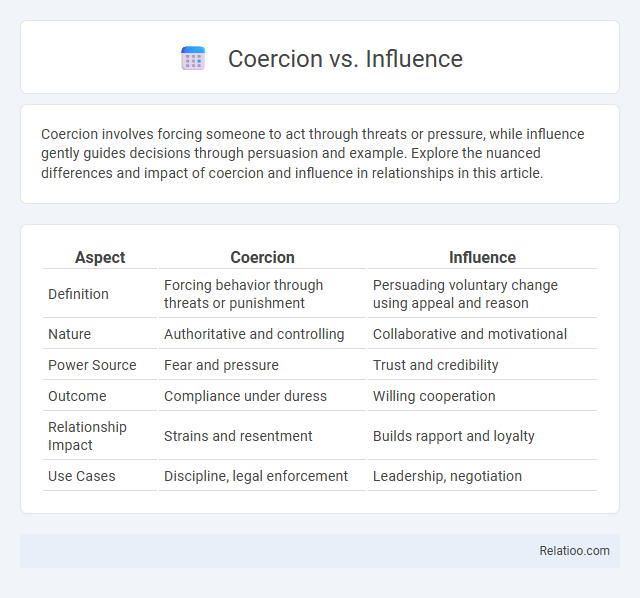Coercion involves forcing someone to act through threats or pressure, while influence gently guides decisions through persuasion and example. Explore the nuanced differences and impact of coercion and influence in relationships in this article.
Table of Comparison
| Aspect | Coercion | Influence |
|---|---|---|
| Definition | Forcing behavior through threats or punishment | Persuading voluntary change using appeal and reason |
| Nature | Authoritative and controlling | Collaborative and motivational |
| Power Source | Fear and pressure | Trust and credibility |
| Outcome | Compliance under duress | Willing cooperation |
| Relationship Impact | Strains and resentment | Builds rapport and loyalty |
| Use Cases | Discipline, legal enforcement | Leadership, negotiation |
Defining Coercion: Concepts and Characteristics
Coercion involves forcing someone to act against their will through the use or threat of physical or psychological harm, distinguishing it from influence, which relies on persuasion and voluntary acceptance. Key characteristics of coercion include the presence of pressure, a lack of genuine consent, and the potential for negative consequences if compliance is not achieved. Understanding these concepts helps you identify when your decisions may be compromised by coercive tactics rather than genuine influence or free choice.
Understanding Influence: Meaning and Mechanisms
Influence involves shaping your thoughts or actions through persuasion, social proof, or appeal to emotions without force or intimidation. Unlike coercion or threats, influence operates through subtle communication, trust, and credibility, enabling voluntary acceptance of ideas or behaviors. Understanding influence requires recognizing psychological mechanisms such as reciprocity, authority, and liking that drive people to comply willingly.
Key Differences Between Coercion and Influence
Coercion involves the use of force or threats to compel someone to act against their will, whereas influence relies on persuasion and appeal to change behavior voluntarily. Your ability to differentiate between these tactics is crucial when navigating ethical decision-making, as coercion undermines autonomy while influence respects personal choice. Threats imply potential harm, making coercion a hostile strategy, while influence fosters cooperation through trust and mutual respect.
Psychological Impact of Coercion vs. Influence
Coercion exerts a powerful psychological impact by instilling fear, anxiety, and a sense of helplessness, often leading to long-term emotional trauma and diminished self-esteem. Influence, while also shaping behavior, operates through persuasion and social cues, fostering voluntary acceptance and positive reinforcement without the damaging effects of fear. Understanding the psychological dichotomy between coercion and influence is crucial for developing ethical communication strategies and maintaining mental well-being in interpersonal and organizational contexts.
Ethical Considerations in Coercion and Influence
Coercion involves using force or intimidation to compel behavior, raising significant ethical concerns due to its potential to violate autonomy and consent. Influence relies on persuasion and often aligns with ethical standards by respecting individual choice while guiding decisions. Ethical considerations emphasize that influence should promote informed consent and voluntary action, whereas coercion undermines freedom and can lead to exploitation or harm.
Real-Life Examples: Coercion in Practice
Coercion in practice often involves forcing someone to act against their will through threats or intimidation, such as an employer threatening job loss if an employee refuses unethical tasks. Influence differs by shaping decisions through persuasion or incentives, like a mentor encouraging skill development to advance a career. Your understanding of these distinctions helps recognize coercive tactics and respond effectively in real-life situations.
Case Studies: Influence in Action
Case studies demonstrate how influence operates through subtle persuasion techniques and relationship-building to guide decision-making without force or intimidation. Unlike coercion or threats, effective influence leverages trust, shared goals, and credibility to create voluntary compliance and long-term behavioral change. Your ability to distinguish influence from coercion ensures ethical leadership and sustainable success in negotiations and organizational settings.
Legal Perspectives on Coercion vs. Influence
Legal perspectives distinguish coercion as the use of force or intimidation to compel someone's actions, which can invalidate consent or contracts, whereas influence involves persuasion without unlawful pressure. Coercion typically invokes criminal or civil liability due to its violation of free will, while influence remains a lawful tool in negotiation and decision-making. Understanding these distinctions helps protect Your rights by identifying when pressure crosses into illegal compulsion.
Strategies to Resist Unwanted Coercion and Influence
Effective strategies to resist unwanted coercion and influence include strengthening personal boundaries, developing critical thinking skills, and fostering emotional resilience. Recognizing manipulation tactics such as pressure, guilt, or fear allows individuals to respond assertively and maintain autonomy. Building a supportive network and seeking professional guidance can also empower individuals to counteract coercive or influential forces.
The Role of Coercion and Influence in Leadership
Coercion and influence play distinct roles in leadership, where coercion relies on force or intimidation to achieve compliance, often resulting in short-term obedience but long-term resistance. Influence, grounded in persuasion and trust, fosters commitment and motivates Your team toward shared goals, enhancing collaboration and morale. Effective leaders balance these to maintain authority while promoting a positive organizational culture.

Infographic: Coercion vs Influence
 relatioo.com
relatioo.com